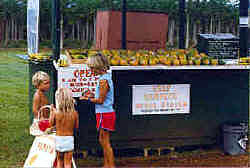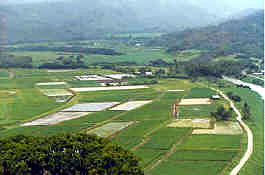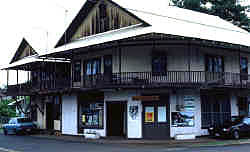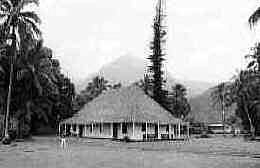Travel
Search
KAUAINorth of LihueHarlan Hague |
|
I had never been to Kauai, but it had fascinated me for years. I had heard it described as a lush paradise, with associations with whalers, Russians, Captain Cook, and a race of two-foot tall indigenous people who lived in Kauai before the arrival of the first Polynesians. The island also was reported to be the home of Puff, the Magic Dragon. I can report that it is all true. It certainly is lush, the greenest of all the islands in the Hawaiian chain. The center of the island, in the vicinity of two peaks that exceed five thousand feet, is the wettest spot on earth, averaging five hundred inches rainfall per year. The coastal areas, where the population centers and most attractions are located, are considerably more moderate.Most visitors arrive at Lihue airport, a twenty-minute flight from Honolulu. Car rental agencies are adjacent to the terminal. Unfortunately, you cannot see Kauai without a car or on a tour bus. Kauai has no public transportation system suitable for tourists, so the roads are usually busy. There are two drives that will take you to most of the island's attractions. One leads west of Lihue and terminates at the spectacular Waimea Canyon. It is wise, before setting out on this drive, to telephone the forest ranger to ask about the weather, 335-5871. The canyon often is obscured by fog. If that is the case, save this drive and hope for a clear day tomorrow. The other drive heads northward on Highway 56 (Kuhio Highway) along the eastern and northern shore. It is only forty miles to the end of the road on the north coast, but set aside the entire day for the round trip. Only a few minutes north of Lihue, you arrive in Kapaia. Watch for the sign on the left for Wailua Falls. Drive about three miles through cultivated fields to the signposted overlook. The distant view of the falls and its gorge are worth the trip. Now turn around and return to Kapaia. Continue northward on Highway 56 to Hanamaulu. Stop a few minutes at the Museum for a glimpse of old Kauai, both before and after contact with outsiders. Snack and craft shops are nearby. If you fancy a morning swim, ask directions to Hanamaulu Beach. It is a quiet little strip of sand, with a tree-shaded picnic area. Back on Highway 56, you soon come to the mouth of Wailua River, one of the best-known and historic spots in the islands. It was here that the first Polynesians landed and settled. Today, at Lydgate State Park, there is a rock-protected lagoon where children bathe safely, and snorkeling is popular. Cross the highway and drive up the road on the south side of Wailua River to the Wailua Marina Restaurant. Dining on the shaded terrace is not elegant, but fun. It is less crowded in the evening. The reason it is so busy during the day is that the same building that houses the restaurant also includes the ticket offices of the two charter boat services that take hundreds of visitors daily to Fern Grotto, probably the most popular attraction on the island. The trip in covered, barge-like boats takes 1 1/2 hours and costs $7 for adults. You are entertained en route with Hawaiian music and hula dancers, anecdotes and jokes. At the landing upstream, passengers disembark and file together through a lush tropical forest to the beautiful, fern-shrouded cavern where the musicians sing the "Hawaiian Wedding Song." Then the group walks by a different route back to the waiting boat. If you can enjoy the river and the forest in spite of the regimentation, then see Fern Grotto. Otherwise, skip it. Drive back to Highway 56 now, and cross the Wailua River. A hundred yards on the left, you will see the Coco Palms Hotel. It is one of the select few fine, gracious, old island hostelries that year by year grow in popularity (and, alas, in price, though the minimum rate of $78. is not outrageous by resort standards). If you want to have just one good bash in Kauai, have dinner at Coco Palms and watch the dramatic torch-lighting ceremony on the lagoon. If you want the drama without the price, stand on the walkway outside the open dining room and watch. Finish the evening with drinks and dancing at the bar adjacent to the dining room. Just a bit farther north take the left turning on Highway 580. A pleasant drive along the picturesque Wailua River takes you to a viewpoint for the Opaekaa Falls, tumbling dramatically over a high cliff. After enjoying the view, return to Highway 56. A short drive takes you to the Coconut Plantation complex of hotels, restaurants and the best shopping on the island: the Market Place. This is an attractive grouping of about eighty shops in an integrated, beautifully landscaped setting, selling everything from Kona coffee and Niihau leis to jeans and needlepoint. There are also movie theatres and a variety of snack shops and restaurants. If you must shop, this is the place. Back on Highway 56, drive about eighteen miles to Kilauea. Keep a sharp lookout on the right, and turn at the sign for the lighthouse. A hundred yards or so after turning off the highway, you will see on the right the Christ Memorial Episcopal Church. The Church of England, the preferred denomination of King Kamehameha IV and Queen Emma, began its ministry in Honolulu in 1862. An Anglican mission was opened in Kauai about twenty years later. Following the annexation of Hawaii by the United States, the Church of England in 1902 transferred its work in the islands to its daughter church, the Protestant Episcopal Church of the United States. The present building was constructed in 1941 of native lava rock on land donated by the Kilauea Sugar Company. The handsome stained glass windows were fashioned in England. The graveyard surrounding the church dates from the days of the Hawaiian Congregational Church, which preceded the Anglican church here. Just past the church, turn left, still following the signs to the lighthouse. Shortly
after the turning, there is (at least, there was) a small fruit stand At the end of the road, a one-lane paved track leads to the parking area for the Kilauea Lighthouse. Walk up to the grassy plateau, stopping often to look at the wild spectacle below where the waves crash on the rocky shore line. Watch the boobies and great frigatebirds with their seven-foot wingspread and other graceful sea birds overhead, drifting almost motionlessly in the brisk wind. This is a bird sanctuary, and the variety of species is surprising. Exceptionally knowledgeable uniformed volunteers explain the habits and habitat of the local birds. We watched a distant squall as it approached, then ran with others to the little visitor center at the foot of the lighthouse. On the way back to Highway 56, stop at Kong Lung Company in Old Kilauea Town. Watch for it on your left. Dating from 1881, Kong Lung Company originally was a Chinese general store that catered to the needs of the workers of the Kilauea Sugar Plantation. The interesting building, with exposed beams and traditional corrugated iron roof is now a modern emporium, selling aloha wear, muumuus, Hawaiian crafts, jewelry and antiques. Traditional Hawaiian music provides a pleasant background for browsing. There is a new Italian restaurant next door, with tables on a broad, covered porch. On the next street, stop at Jacques of Kauai bakery for morning coffee. We arrived just before a soft rain began to fall. We had our coffee and tea and light, flaky Danish at a table on the narrow porch, enjoying the shower. After your respite, take away a hearty rye molasses baguette. Jacques is an authentic Frenchman, and his breads and pastries are authentically French. I hope his plans for modernizing the bakery will not prove the end of its charm. Back on Highway 56, the road begins to climb. After about five miles, watch carefully
for the Hanalei Valley turnout on the left side of the road. You will be treated here to
the best view on the The highway now drops down into the valley. Stop for lunch at the Hanalei Shell House
Restaurant. It has a delightful island atmosphere, with open sides, slat shutters and
corrugated metal roof. Order one of the half-pound Nearby, the Old Ching Young General Store is now the Native Hawaiian Trading and Cultural Center. Time and weather permitting, it is worth a stop. By all means, don't miss the Waioli Mission House. Built in 1837, the two-story frame house has been lovingly restored by descendants of the first missionaries and is furnished with pieces of that period. The house is located behind the Waioli Church, a perfectly delightful small frame church. The building is an architectural gem, painted green and trimmed in white. It fronts on the highway. Back on the road, you now pass by some of the most beautiful beaches in the islands,
the Hawaii of the imagination and the picture books. Lumahai Beach is first, a long bench
of golden sand that blends harmoniously with the turquoise Continue on and stop for short visits at two caves on the left side of the road. Be careful at this point. Before reaching the caves, there is a ford that usually has only a thin sheet of water crossing it. After a hard rain, the trickle becomes a flood. The first cave is the Maniniholo Dry Cave. The huge cavern has a flat, sandy floor and a stone ceiling that is ten feet or more high. Hundreds could find shelter here with no crowding. Waikanaloa Wet Cave is only a short distance away. The floor of the cave is a pool of fresh water. Tradition holds that chiefs gathered at the caves in ancient times. Drive a quarter mile or so to the Ke'e beach at the end of the road. If you chance to be there on a sunny day, enjoy it quickly. The north side of the island is the wettest side. Even if it is overcast or dripping, as it was when I saw it last, the place still has a pull for me. Walk out on the beach, then turn back for a view of the mountains. Ponder the scene as the old Hawaiians might have seen it. This site was sacred to the goddess of the hula. Hawaiians came here from all the islands to learn the dance and perform religious rites associated with it. West of Ke'e are the jagged peaks of the roadless Na Pali Coast. The region is accessible by trail--take solid rain gear--or by boat. One outfit, Ancient Hawaiian Adventures, will take you ashore through the surf in a catamaran under sail. Other boat trips are less adventurous, but the view is no less spectacular. A more comfortable and increasingly popular way of seeing the coast is by helicopter. Frankly, I think the trend toward viewing natural wonders all over the United States by helicopter and small plane is abominable. The sudden appearance of a noisy, low-flying aircraft ruins the pristine quality of the wilderness for the hundreds of other visitors who stand at scattered viewpoints, pondering its mystery and beauty. Nevertheless, if that's your pleasure, there are a number of companies that provide the service. Now begin your return journey, leisurely, and enjoy the countryside. Whitefaced Herefords and black cattle graze in park-like meadows, and sugar cane fields are everywhere. In the villages, take time to drive off the highway and took at the old buildings, "old" being anything that pre-dates World War II. Stop for dinner at the Hanamaulu Restaurant and Tea House, just a mile or two north of Lihue. Ask to be seated in one of the rooms that surround the Japanese garden. You leave your shoes outside the room and sit on tatami (reed mat). You aren't required to sit on your feet, as in traditional Japanese restaurants, since the trench under the low table permits a comfortable sitting posture. The rooms look out over the delicately landscaped garden around a pool with multi-colored carp. Pebbled paths and small pagodas complete the peaceful setting. Dinners are reasonable, from $5 to $10. There is additional seating inside the restaurant, but to assure a place in a tea room, you should call the previous day for a reservation (245-2511). It is popularly believed that travel in Hawaii is only for the well-heeled. If you want luxury, Hawaii has it in great store. But if you are budget-minded, you will have no difficulty finding good accommodations and restaurants at moderate prices. For general information on visiting Hawaii, write to Hawaii Visitors Bureau, 2270 Kalakaua Avenue, Honolulu, Hawaii 96815, or write directly to branch offices of the bureau in San Francisco, Los Angeles, New York, or Chicago. See your telephone directory for addresses. |
|
Caveat and disclaimer: This is a freelance travel article that I published some time ago. Some data, especially prices, links and contact information, may not be current. |
|
|
|
|
 displaying ripe bananas and mangoes. The fruit was grown in the orchards
adjacent. Three small children, wide-eyed and friendly, helped us make our selections. A
bright, little five-year-old gave us an informed description of the feel and look of a
ripe mango. The small fruit stand, flying the United States and Hawaiian flags, was not
attended. Prices were marked, and we dropped our coins in the dish provided. Shades of
1930s America! I walked away with a light step. As we drove away, I decided that one of
the small, tree-ripened bananas would not ruin my appetite for lunch. I ate four.
displaying ripe bananas and mangoes. The fruit was grown in the orchards
adjacent. Three small children, wide-eyed and friendly, helped us make our selections. A
bright, little five-year-old gave us an informed description of the feel and look of a
ripe mango. The small fruit stand, flying the United States and Hawaiian flags, was not
attended. Prices were marked, and we dropped our coins in the dish provided. Shades of
1930s America! I walked away with a light step. As we drove away, I decided that one of
the small, tree-ripened bananas would not ruin my appetite for lunch. I ate four.  island. Below, the placid Hanalei River flows through
the patchwork valley of neatly-terraced taro patches. In the background, the mountain
ridge, green-black with sharply eroded canyons, is often shrouded in a gauze-like fog. Sit
and contemplate an early Hawaii, the Hawaii of dreams and fantasies. If your schedule
permits, come back to see the same view at sunset.
island. Below, the placid Hanalei River flows through
the patchwork valley of neatly-terraced taro patches. In the background, the mountain
ridge, green-black with sharply eroded canyons, is often shrouded in a gauze-like fog. Sit
and contemplate an early Hawaii, the Hawaii of dreams and fantasies. If your schedule
permits, come back to see the same view at sunset.  hamburgers
with vegetables, and share it with a friend. The clam chowder is excellent, especially on
a cool day. If you are lucky, it will rain while you are enjoying your lunch. When I was
there, there was a magnificent cloudburst, with blowing sheets of rain and rolling
thunder. A young man came running toward the door, fell headlong and slid in the mud. He
came inside, laughing and joking, dripping mud. Anywhere but Hawaii, he likely would have
turned the room blue with his anger. Everyone enjoyed his predicament with him.
hamburgers
with vegetables, and share it with a friend. The clam chowder is excellent, especially on
a cool day. If you are lucky, it will rain while you are enjoying your lunch. When I was
there, there was a magnificent cloudburst, with blowing sheets of rain and rolling
thunder. A young man came running toward the door, fell headlong and slid in the mud. He
came inside, laughing and joking, dripping mud. Anywhere but Hawaii, he likely would have
turned the room blue with his anger. Everyone enjoyed his predicament with him.  water and the nearby gray-green mountain ridge. The Haena beaches follow, particularly
noted for their beauty. The lush flora, coconut palms, sandy beaches and inviting surf
should satisfy anyone's vision of tropical paradise. It is no wonder that the region was
selected as the fabled Bali Hai in the movie version of "South Pacific." You may
recognize Lumahai Beach as the film's Nurses' Beach.
water and the nearby gray-green mountain ridge. The Haena beaches follow, particularly
noted for their beauty. The lush flora, coconut palms, sandy beaches and inviting surf
should satisfy anyone's vision of tropical paradise. It is no wonder that the region was
selected as the fabled Bali Hai in the movie version of "South Pacific." You may
recognize Lumahai Beach as the film's Nurses' Beach.